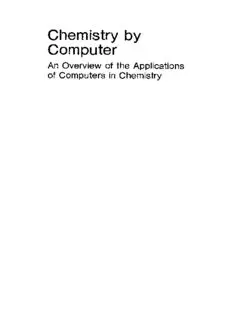Table Of ContentChemistry by
Computer
An Overview of the Applications
of Computers in Chemistry
Chemistry by
Computer
An Overview of the Applications
of Computers in Chemistry
Stephen Wilson
Theoretical Chemistry Department
University of Oxford
Oxford, England
PLENUM PRESS • NEW YORK AND LONDON
Library of Congress Cataloging in Publication Data
Wilson, S. (Stephen), 1950-
Chemistry by computer.
Includes bibliographies and index.
1. Chemistry-Data processing. I. Title.
QD39.3.E46W55 1986 542'.8 86-18746
ISBN-13: 978-1-4612-9262-3 e-ISBN-13: 978-1-4613-2137-8
DOl: 10.t007/978-1-4613-2137-8
First Printing-October 1986
Second Printing-November 1987
© 1986 Plenum Press, New York
Softcover reprint of the hardcover 1st edition 1986
A Division of Plenum Publishing Corporation
233 Spring Street, New York, N.Y. 10013
All rights reserved
No part of this book may be reproduced, stored in a retrieval system, or transmitted
in any form or by any means, electronic, mechanical, photocopying, microfilming,
recording, or otherwise, without written permission from the Publisher
To Kati and Jonathan
Preface
Computers have been applied to problems in chemistry and the
chemical sciences since the dawn of the computer age;
however, it is only in the past ten or fifteen years that we have
seen the emergence of computational chemistry as a field of
research in its own right. Its practitioners, computational
chemists, are neither chemists who dabble in computing nor
programmers who have an interest in chemistry, but computa
tional scientists whose aim is to solve a wide range of chemical
problems using modern computing machines.
This book gives a broad overview of the methods and
techniques employed by the computational chemist and of the
wide range of problems to which he is applying them. It is
divided into three parts. The first part records the basics of
chemistry and of computational science that are essential to an
understanding of the methods of computational chemistry.
These methods are described in the second part of the book. In
the third part, a survey is given of some areas in which the
techniques of computational chemistry are being applied. As a
result of the limited space available in a single volume, the areas
covered are necessarily selective. Nevertheless, a sufficiently
wide range of applications are described to provide the reader
with a balanced overview of the many problems being attacked
by computational studies in chemistry.
vii
viii Preface
It is intended that this book should prove useful to a wide
variety of scientists. Undergraduate chemists will use it as an
introduction to computational chemistry. Experimental re
search chemists should use this book to gain an understanding
of the ways in which the techniques of computational chemistry
can aid their research programs. These techniques have
potential applications in fields as diverse as radioastronomy and
astrochemistry, solid-state and nuclear physics, organic synthe
tic chemistry, catalysis, molecular biology, pharmacology, and
molecular electronics. Although the present volume does not
provide a detailed survey of any of these fields, it does present a
broad overview of many of them. A bibliography is given at the
end of each chapter to enable the interested reader to investi
gate a particular method or application in more detail.
Stephen Wilson
Finstock, Oxford
Contents
PART I. BASICS
1. Introduction ..... 3
2. Chemistry by Computer 7
2.1. Computational Chemistry 7
2.2. Isolated Atoms and Molecules 9
2.3. Bulk Properties of Atoms and Molecules 14
Bibliography . . . . . . . . . . 17
3. Computers and Computation. . . 19
3.1. Computers, Computer Science, and the
Computational Sciences 19
3.2. Hardware . . . . . . . 21
3.3. Software . . . . . . . 24
3.3.1. High-Level Languages 24
3.3.2. Software Engineering. 28
3.4. Future Directions 34
Bibliography . . . . . . 36
PART II. METHODS
4. Quantum Chemistry 41
4.1. Quantum Chemistry 41
ix
x Contents
4.2. The Schrodinger Equation . . . . 42
4.3. The Electronic Schrodinger Equation. 44
4.4. Self-Consistent-Field Calculations 57
4.5. Electron Correlation . . . . 65
4.6. Theoretical Model ChemIstry 71
4.7. The Nuclear Schrodinger Equation 73
Bibliography . . . . . . . . 83
5. Molecular Mechanics 85
5.1. Ball-and-Stick Models . 85
5.2. The Force Field . . . 87
5.3. Minimization of the Energy 98
5.3.l. Conjugate-Direction Methods 99
5.3.2. Newton Methods 102
5.4. An Example: n-Butane . 105
5.5. Molecular Mechanics 109
Bibliography . . . 110
6. Chemical Reactions III
6.l. Reactions . . . . III
6.2. Molecular Collisions 112
6.3. Chemical Kinetics 121
6.4. Organic Synthetic Routes 125
Bibliography . . . . 133
7. Simulation of Liquids and Solids 135
7.1. The Condensed Phases of Matter 135
7.2. Liquid Simulation . . . . . 135
7.3. The Monte Carlo Method 138
7.4. The Molecular-Dynamics Method 153
7.5. Simulation of Solids . 160
Bibliography . . . . 163
PART III. APPLICATIONS
8. Interstellar Molecules and
Interstellar Chemistry 167
8.1. Background 167
Contents xi
8.2. Molecules in Space . . . . . . . . . . 168
8.3. Computational Studies of Interstellar Radicals
and Ions. . . . . . . . . . . 174
8.3.1. Protonated Nitrogen Molecule. 177
8.3.2. Cyanoethynyl Radical. . . 179
8.3.3. Butadiynyl Radical. . . . . 180
8.3.4. Metastable Organic Radicals. . 182
8.3.5. Radicals and Ions Containing Second-Row
Atoms . . . 183
8.3.6. Rare-Gas Ions 183
8.4. Interstellar Chemistry 185
Bibliography . . . 188
9. Computational Pharmacology. 189
9.1. Background . . . . . 189
9.2. Theoretical Pharmacology 191
9.3. Molecular Graphics 194
Bibliography . . . 199
10. Molecular Biology 201
10.1. Background 201
10.2. Proteins . . . . 202
10.3. Computational Studies of Proteins 207
Bibliography . . . . . . . 213
11. New Horizons 215
11.1. Preamble 215
11.2. Molecular Electronics 217
11.3. Molecular Rectifiers . 218
11.4. Molecular Computers 223
Author Index. 225
Subject Index 227
PART I
BASICS

